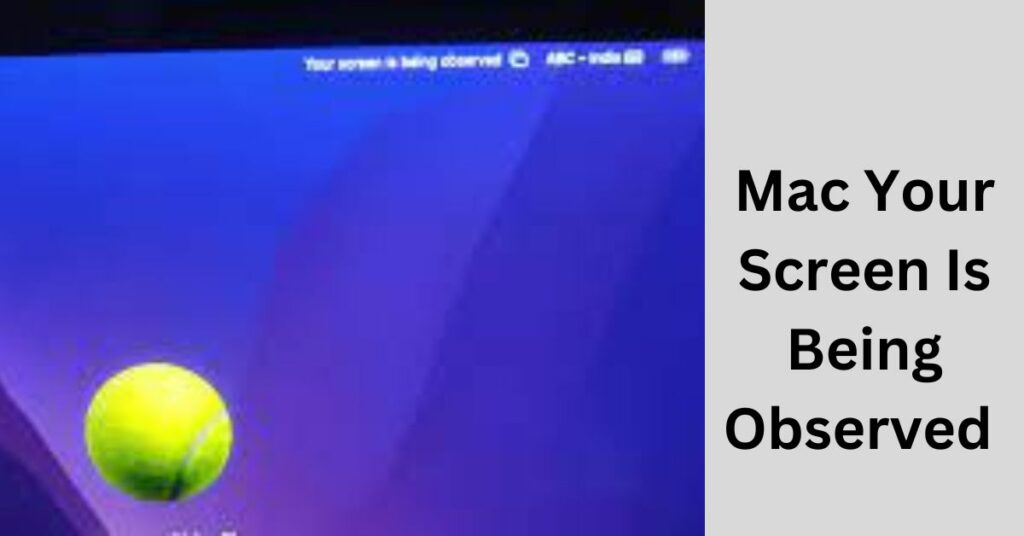Mac Your Screen Is Being Observed – The Ultimate Guide For You!

In the era of advanced technology and digital connectivity, privacy and security concerns have become paramount, especially for users of personal computers like Mac.
As we immerse ourselves in the convenience and efficiency of modern computing, it’s crucial to recognize that our screens may be under observation, posing potential risks to our digital privacy.
This article explores the various aspects of screen observation on Mac, the reasons behind it, and the measures one can take to safeguard their privacy.
Table of Contents
Understanding Screen Observation – Here To Know!
Screen observation refers to the unauthorized monitoring or recording of a user’s computer screen activities. This could be done for various reasons, ranging from potential cyber threats to more benign purposes like employee productivity monitoring. In the context of Mac, a user might face screen observation through malicious software, spyware, or even built-in features that, if misused, can compromise privacy.
Mac users have to be aware of potential cyber threats and take the necessary measures to protect their data and privacy. This includes using strong passwords, installing antivirus software, and avoiding suspicious websites.
Built-in Features and Their Intended Use – Check It Out!
Mac computers come equipped with several built-in features designed to enhance user experience and productivity. Some of these features, however, can potentially be used for screen observation purposes.
For instance, screen sharing and remote management functionalities are intended to facilitate collaboration and technical support. Users can share their screens with others to troubleshoot issues or seek assistance, but it’s essential to use these features judiciously and only with trusted individuals.
Third-Party Applications – Go In-Depth!
The App Store offers a plethora of third-party applications that claim to enhance productivity or provide additional functionalities. While many of these apps are legitimate, some may pose privacy risks. Users should exercise caution and thoroughly research any application before installing it on their Mac. Always check reviews, ratings, and permissions required by the app to ensure it doesn’t compromise your privacy.
1. Unauthorized Access:
Malicious actors can exploit vulnerabilities in your system to gain unauthorized access to your screen. This can lead to the exposure of sensitive information, including personal data, financial details, and confidential documents.
2. Identity Theft:
Screen observation can be a precursor to identity theft. Cybercriminals may monitor your online activities, capturing login credentials, personal information, and other data that could be used to impersonate you.
3. Corporate Espionage:
For business users, the risk of corporate espionage is a serious concern. Competitors or malicious entities may attempt to observe screens to gain insights into proprietary information, business strategies, or trade secrets.
Protecting Your Mac Screen – Explore Now!
To mitigate the risks associated with screen observation on your Mac, follow these essential security practices:
1. Keep Software Updated:
Regularly update your operating system and all installed applications to ensure that you have the latest security patches. Developers often release updates to address vulnerabilities that could be exploited by attackers.
2. Use Reliable Security Software:
Install reputable antivirus and anti-malware software on your Mac. These programs can help detect and remove malicious software that may attempt to observe your screen.
3. Be Cautious with Third-Party Apps:
Carefully vet any third-party applications before installing them. Only download apps from trusted sources, and review the permissions they request. Avoid granting unnecessary access to your system.
4. Secure Your Network:
Use strong, unique passwords for your Wi-Fi network and enable WPA3 encryption. A secure network helps protect against unauthorized access to your devices.
5. Disable Unused Services:
If you’re not using screen sharing or remote management features, consider disabling them. This reduces the potential attack surface and minimizes the risk of unauthorized access.
6. Employ a Virtual Private Network (VPN):
A VPN encrypts your internet connection, enhancing your online privacy and preventing potential eavesdropping. Use a reliable VPN service, especially when connected to public Wi-Fi networks.
7. Educate Yourself:
Stay informed about the latest cybersecurity threats and best practices. Awareness is a powerful tool in protecting yourself against potential risks.
Advanced Security Measures – Dig Into It!
1. Two-Factor Authentication (2FA):
Enable 2FA for your Apple ID and other crucial accounts. This adds an extra layer of security by requiring a secondary verification step, typically through a code sent to your mobile device.
2. Firewall Configuration:
Configure the built-in firewall on your Mac to monitor and control incoming and outgoing network traffic. This helps prevent unauthorized access and potential screen observation attempts.
3. FileVault Encryption:
Activate FileVault, the built-in disk encryption program on Mac. This ensures that your data is encrypted, adding an extra layer of protection in case your device falls into the wrong hands.
4. Privacy Preferences:
Regularly review and adjust privacy preferences in your system settings. Specify which applications have access to sensitive data such as your camera, microphone, and screen recording capabilities.
Legal Considerations – Uncover The Truth!
1. Employee Monitoring Policies:
For users in a professional setting, be aware of any employee monitoring policies in place. Employers may have the right to observe screen activities during work hours, but this should be communicated and within legal boundaries.
2. Data Protection Regulations:
Understand relevant data protection regulations such as GDPR (General Data Protection Regulation) and ensure that your screen observation practices comply with these laws. These regulations provide guidelines on how personal data should be handled and protected.
Conclusion:
At the end of the article,
As we embrace the ease and efficiency of contemporary computing, it becomes imperative to acknowledge that our screens could be subject to observation, presenting potential threats to our digital privacy.